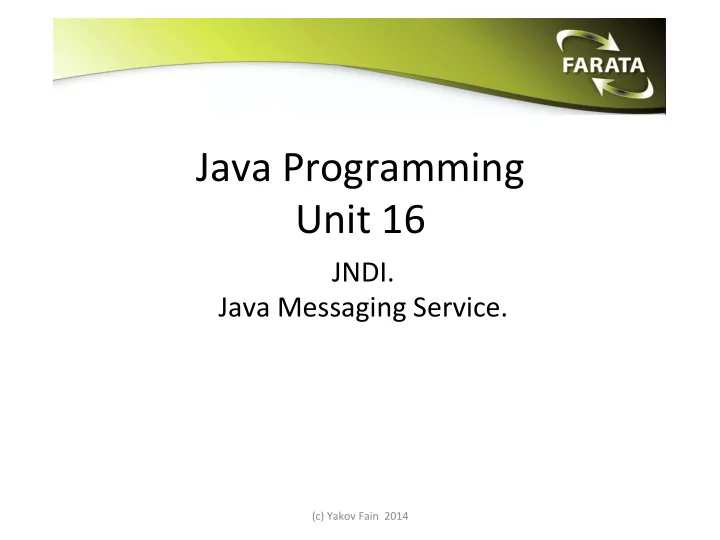

Java ¡Programming ¡ ¡ Unit ¡16 ¡ JNDI. ¡ ¡ Java ¡Messaging ¡Service. ¡ ¡ ¡ (c) ¡Yakov ¡Fain ¡ ¡2014 ¡
Java ¡Naming ¡and ¡Directory ¡ Interface ¡(JNDI) ¡
Java ¡Naming ¡and ¡Directory ¡Interface ¡ Naming ¡and ¡directory ¡servers ¡are ¡registries ¡of ¡objects. ¡ ¡ ¡ JNDI ¡helps ¡Java ¡objects ¡in ¡finding ¡required ¡resources ¡(e.d. ¡data ¡ source, ¡message ¡queue, ¡etc.). ¡ ¡ ¡ ¡ Every ¡Java ¡app ¡server ¡creates ¡internal ¡JNDI ¡tree ¡of ¡objects. ¡ ¡ Administrator ¡ binds ¡resources ¡to ¡the ¡names ¡in ¡the ¡JNDI ¡tree. ¡This ¡ is ¡done ¡via ¡Admin ¡Console, ¡using ¡scripts, ¡or ¡XML ¡deployment ¡ descriptors. ¡ ¡ ¡ ¡ ¡ ¡ ¡
Java ¡Naming ¡and ¡Directory ¡Interface ¡ • JNDI ¡ InitialContext ¡is ¡the ¡root ¡of ¡JNDI ¡tree ¡ • If ¡your ¡Java ¡code ¡runs ¡inside ¡Java ¡EE ¡server, ¡it ¡can ¡ inject ¡the ¡ entries ¡from ¡JNDI ¡to ¡your ¡code ¡using ¡ @Resource annotaTon. ¡ ¡ ¡ • Your ¡program ¡can ¡also ¡run ¡a ¡ lookup() ¡on ¡JNDI ¡tree ¡to ¡find ¡ resources. ¡ • Standalone ¡Java ¡programs ¡can ¡only ¡invoke ¡ lookup() ¡to ¡find ¡ the ¡objects. ¡
GeVng ¡IniTalContext ¡ ¡ Java ¡program ¡inside ¡the ¡app ¡server: ¡ ¡ Context namingContext = new InitialContext(); ¡ Java ¡program ¡outside ¡of ¡the ¡app ¡server ¡(a ¡Glassfish-‑specific ¡example): ¡ ¡ ¡ final Properties env = new Properties(); // JNDI properties are not the same in every Java EE server env.put("java.naming.factory.initial”, "com.sun.enterprise.naming.SerialInitContextFactory"); props.setProperty("java.naming.factory.url.pkgs","com.sun.enterprise.nami ng"); props.setProperty("java.naming.factory.state”,"com.sun.corba.ee.impl.pres entation.rmi.JNDIStateFactoryImpl"); props.setProperty("org.omg.CORBA.ORBInitialHost", "localhost"); props.setProperty("org.omg.CORBA.ORBInitialPort", "8080"); Context namingContext = new InitialContext(env);
JMS ¡Administered ¡Objects ¡ • JMS ¡desTnaTons ¡(queues, ¡topics) ¡and ¡connecTon ¡factorues ¡are ¡typically ¡ maintained ¡by ¡adminitrators. ¡ • Administrators ¡configure ¡(bind) ¡administered ¡objects ¡to ¡naming ¡servers ¡ (JNDI, ¡LDAP). ¡ • ConnecTon ¡factory ¡provides ¡connecTvity ¡to ¡MOM ¡server. ¡ • ConnecTon ¡factory ¡is ¡an ¡instance ¡of ¡ ConnectionFactory, QueueConnectionFactory, TopicConnectionFactory • DesTnaTons ¡are ¡instances ¡of ¡ Topic or ¡ Queue.
Resource ¡InjecTon ¡ • InjecTon ¡decouples ¡your ¡code ¡from ¡implementaTon ¡of ¡its ¡ dependencies ¡ • Resource ¡injecTon ¡allows ¡to ¡inject ¡any ¡ JNDI resource into ¡a ¡ container-‑managed ¡object, ¡e.g. ¡servlet, ¡ejb, ¡REST ¡endpoint. ¡ @Resource(name=“java:comp/DefaultDataSource) private javax.sql.DataSource myDataSource; @Resource(lookup ="java:/ConnectionFactory") ConnectionFactory connectionFactory; @Resource(lookup = "queue/test") Queue testQueue;
Resource ¡Lookup ¡ • Finding ¡JMS ¡ConnecTon ¡factory: ¡ ¡ ConnectionFactory connectionFactory = (ConnectionFactory) namingContext.lookup(connectionFactoryString); ¡ ¡ • Finding ¡a ¡JMS ¡desTnaTon ¡(e.g. ¡a ¡msg ¡queue ¡ test ): ¡ Destination destination = (Destination) namingContext.lookup(“jms/queue/test");
Java ¡Messaging ¡Service ¡(JMS) ¡
JMS ¡and ¡MOM ¡ • Message ¡Oriented ¡Middleware ¡(MOM) ¡is ¡a ¡transport ¡for ¡ messages, ¡e.g. ¡EMS, ¡WebSphereMQ, ¡AcTveMQ, ¡et ¡al. ¡ MOM ¡is ¡also ¡known ¡as ¡JMS ¡Provider ¡ ¡ • JMS ¡stands ¡for ¡Java ¡Messaging ¡Service ¡ ¡ ¡ • JMS ¡is ¡an ¡API ¡for ¡working ¡with ¡one ¡of ¡the ¡MOM ¡servers ¡ ¡ • MOM ¡is ¡like ¡a ¡postal ¡service ¡ (c) ¡Yakov ¡Fain ¡ ¡2014 ¡
Point-‑to-‑Point ¡(a.k.a. ¡P2P) ¡Architecture ¡ Point-‑to-‑Point ¡ messaging ¡is ¡when ¡a ¡program ¡ sends ¡a ¡message ¡to ¡a ¡ parTcular ¡queue ¡and ¡and ¡a ¡ single ¡ consumer ¡receives ¡the ¡message ¡ from ¡this ¡queue. ¡ ¡ ¡ In ¡this ¡mode ¡the ¡message ¡is ¡removed ¡from ¡a ¡queue ¡( de-‑queued ) ¡ as ¡soon ¡as ¡it’s ¡successfully ¡delivered ¡to ¡the ¡consumer. ¡ ¡ (c) ¡Yakov ¡Fain ¡ ¡2014 ¡
Publish/Subscribe ¡(a.k.a. ¡Pub/Sub) ¡Architecture ¡ If ¡a ¡program ¡publishes ¡a ¡message ¡for ¡mulTple ¡consumers, ¡it’s ¡ called ¡ Publish/Subscribe ¡messaging . ¡ ¡ PriceSubscriber ¡1 ¡ Price ¡ ¡ MOM ¡ Quote ¡ PriceSubscriber ¡2 ¡ Publisher ¡ PriceQuoteTopic ¡ PriceSubscriber ¡n ¡ OrderExecuTonTopic ¡ OrderExecSubscriber ¡1 ¡ Order ¡ ¡ ExecuTon ¡ Publisher ¡ OrderExecSubscriber ¡2 ¡ (c) ¡Yakov ¡Fain ¡ ¡2014 ¡
JMS ¡1.1 ¡API ¡Overview ¡ • ¡Queue ¡is ¡a ¡place ¡to ¡put ¡in ¡(or ¡get ¡from) ¡your ¡messages. ¡ A ¡message ¡producer ¡ (sender) ¡ puts ¡messages ¡in ¡a ¡queue ¡and ¡ a ¡message ¡consumer ¡ (receiver) ¡de-‑queues ¡them. ¡ • ¡QueueConnecTon ¡is ¡an ¡interface ¡that ¡represents ¡connecTon ¡to ¡MOM. ¡ • ¡QueueConnecTonFactory ¡is ¡an ¡object ¡that ¡creates ¡ConnecTon ¡objects. ¡ ¡ • ¡QueueSession ¡is ¡an ¡object ¡that ¡represents ¡a ¡parTcular ¡session ¡between ¡the ¡client ¡and ¡ MOM ¡server. ¡QueueConnecTon ¡creates ¡a ¡session ¡object. ¡ • ¡QueueSender ¡is ¡an ¡object ¡that ¡actually ¡sends ¡messages. ¡ • ¡QueueReceiver ¡receives ¡messages. ¡ • ¡TopicPublisher ¡publishes ¡messages ¡(it ¡has ¡similar ¡funcTonality ¡to ¡QueueSender). ¡ • ¡TopicSubscriber ¡is ¡an ¡object ¡that ¡receives ¡messages ¡(similar ¡to ¡QueueReceiver). ¡ • ¡Topic ¡is ¡an ¡object ¡that ¡is ¡used ¡in ¡Pub/Sub ¡mode ¡to ¡represent ¡some ¡applicaTon ¡event. ¡ ¡ • ¡TopicPublisher ¡publishes ¡messages ¡to ¡a ¡topic ¡so ¡the ¡TopicSubscriber(s) ¡could ¡subscribe ¡ for ¡it. ¡ • ¡Message ¡is ¡an ¡object ¡that ¡serves ¡as ¡a ¡wrapper ¡to ¡an ¡applicaTon ¡objects ¡that ¡can ¡be ¡ placed ¡in ¡a ¡JMS ¡queue ¡or ¡published ¡to ¡a ¡topic. ¡ ¡ (c) ¡Yakov ¡Fain ¡ ¡2014 ¡
Message ¡Types ¡ • ¡ TextMessage ¡is ¡an ¡object ¡that ¡can ¡contain ¡any ¡Java ¡String. ¡ • ¡ ObjectMessage ¡can ¡contain ¡any ¡ Serializable Java ¡object. ¡ • ¡ BytesMessage ¡contains ¡an ¡array ¡of ¡bytes. ¡ • ¡ StreamMessage ¡has ¡a ¡stream ¡of ¡Java ¡primiTves. ¡ • ¡ MapMessage ¡contains ¡key/value ¡pairs, ¡e.g. ¡ “id”, 123 . ¡ (c) ¡Yakov ¡Fain ¡ ¡2014 ¡
How ¡to ¡send ¡a ¡message ¡(JMS ¡1.1) ¡ 1. ¡Create ¡(or ¡get) ¡a ¡ ConnectionFactory ¡object. ¡ 2. ¡Create ¡a ¡ Connection ¡object ¡and ¡call ¡its ¡method ¡start(). ¡ 3. ¡Create ¡a ¡ Session ¡object. ¡ 4. ¡Create ¡a ¡ Queue ¡object. ¡ 5. ¡Create ¡a ¡ MessageProducer ¡object. ¡ 6. ¡Create ¡one ¡of ¡the ¡ Message ¡objects ¡(e.g. ¡ TextMessage ) ¡and ¡ put ¡some ¡data ¡in ¡it. ¡ 7. ¡Call ¡the ¡method ¡ send() on ¡the ¡ QueueSender . ¡ 8. ¡Close ¡ QueueSender , ¡ Session ¡and ¡ Connection ¡objects ¡ to ¡release ¡system ¡resources. ¡ ¡ (c) ¡Yakov ¡Fain ¡ ¡2014 ¡
Recommend
More recommend